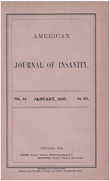Social phobia in adults with stuttering
Abstract
OBJECTIVE: The authors evaluated features of social anxiety in a group of adult stutterers to explore the soundness of the DSM-IV requirement that social phobia not be diagnosed in patients who stutter if their phobia relates to their stuttering. METHOD: They conducted diagnostic interviews and verbal fluency assessments with 16 consecutive adults seeking speech therapy for stuttering. Patients also completed scales measuring social phobia symptoms and associated disability. RESULTS: When DSM-IV criteria were modified to permit a diagnosis of social phobia if phobic symptoms were clearly excessive in relation to the severity of stuttering, seven of the 16 patients were given a diagnosis of social phobia. All seven identified social anxiety as an important source of role impairment. Three of the seven patients entered cognitive-behavioral group therapy and benefited from this intervention. CONCLUSIONS: Many adults seeking treatment for stuttering have salient difficulties with social anxiety that may prove amenable to cognitive-behavioral interventions. By precluding a diagnosis of social phobia in these patients, DSM-IV may hinder the identification of social anxiety as a source of disability and may limit access to treatment.
Access content
To read the fulltext, please use one of the options below to sign in or purchase access.- Personal login
- Institutional Login
- Sign in via OpenAthens
- Register for access
-
Please login/register if you wish to pair your device and check access availability.
Not a subscriber?
PsychiatryOnline subscription options offer access to the DSM-5 library, books, journals, CME, and patient resources. This all-in-one virtual library provides psychiatrists and mental health professionals with key resources for diagnosis, treatment, research, and professional development.
Need more help? PsychiatryOnline Customer Service may be reached by emailing [email protected] or by calling 800-368-5777 (in the U.S.) or 703-907-7322 (outside the U.S.).



